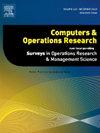现场服务劳动力投资的共识修正启发式
IF 4.3
2区 工程技术
Q2 COMPUTER SCIENCE, INTERDISCIPLINARY APPLICATIONS
引用次数: 0
摘要
劳动力规划是跨各个部门的关键挑战,包括战略、战术和运营决策,以优化利润最大化、温室气体减排和客户满意度等目标。本文将战略劳动力规划问题作为电信现场服务背景下的投资规划,重点研究技术人员路由和调度问题(TRSP)。为了解决这些复杂性,我们提出了一个新的战略框架,其灵感来自一种称为共识修正的新方法。我们的方法使用完整的TRSP模型独立评估一组场景(这里是运营天数),计算每个潜在劳动力投资的价值。然后,共识方案在所有场景中迭代地一个接一个地修复单个劳动力投资决策,直到满足停止标准。这种方法允许并行化并保持较低的计算复杂性,将详细的操作考虑集成到战略决策中。我们将我们的框架应用于来自丹麦电信公司TDC-NET的真实数据,利用自适应大邻居搜索(ANLS)来解决每个场景。研究了不同的共识方案,并通过样本外测试和与新的场景定制解决方案的比较来评估雇佣劳动力的绩效。由于其快速的运行时间,该方法可以为决策者提供广泛的详细劳动力投资解决方案,包括实际的路线,这些解决方案可以透明地展示健壮的劳动力和具有成本效益的劳动力之间的权衡。场景定制的解决方案通过提供最佳驾驶、雇用和未服务任务成本的基准来增强这种透明度,从而帮助评估拟议劳动力的有效性。这为决策者提供了一个坚实的基础,以选择一组平衡客户满意度和运营成本的投资。基于结果,我们还强调了其他几个有价值的管理见解,例如证明更详细的可能投资集合可能并不总是导致更好的结果,并展示如何通过投资后敏感性分析验证我们的方法选择的投资的稳健性。本文章由计算机程序翻译,如有差异,请以英文原文为准。
A consensus fixing heuristic to workforce investments in field service
Workforce planning is a critical challenge across various sectors, encompassing strategic, tactical, and operational decision-making to optimise goals such as profit maximisation, greenhouse emission reduction, and customer satisfaction. This paper addresses the strategic workforce planning problem as investment planning in the context of field service in telecommunications, focusing on the Technician Routing and Scheduling Problem (TRSP).
To tackle these complexities, we propose a novel strategic framework inspired by a new methodology called consensus fixing. Our approach evaluates a set of scenarios (here, operational days) independently using a complete TRSP model, computing the value of each potential workforce investment. A consensus scheme then fixes a single workforce investment decision across all scenarios iteratively, one by one, until a stopping criterion is met. This methodology allows for parallelisation and maintains low computational complexity, integrating detailed operational considerations into strategic decision-making.
We apply our framework to real-life data from the Danish telecommunication company TDC-NET, utilising an Adaptive Large Neighbourhood Search (ANLS) to solve each scenario. Different consensus schemes are investigated, and the performance of the hired workforce is evaluated through out-of-sample testing and comparison to a novel scenario-tailored solution.
Due to its fast run-time, the methodology can equip decision-makers with a wide range of detailed workforce investment solutions, including actual routes, that transparently demonstrate the trade-offs between a robust workforce and a cost-efficient one. The scenario-tailored solutions enhance this transparency by providing a benchmark for the best possible driving, hiring, and unserved task costs, helping to assess how effective a proposed workforce is. This provides decision-makers with a solid foundation for selecting a set of investments that balances customer satisfaction with operational costs.
Based on the results, we also highlight several other valuable managerial insights, such as demonstrating that a more detailed set of possible investments may not always lead to better results, and showing how the robustness of the investments chosen by our methodology can be verified through a post-investment sensitivity analysis.
求助全文
通过发布文献求助,成功后即可免费获取论文全文。
去求助
来源期刊

Computers & Operations Research
工程技术-工程:工业
CiteScore
8.60
自引率
8.70%
发文量
292
审稿时长
8.5 months
期刊介绍:
Operations research and computers meet in a large number of scientific fields, many of which are of vital current concern to our troubled society. These include, among others, ecology, transportation, safety, reliability, urban planning, economics, inventory control, investment strategy and logistics (including reverse logistics). Computers & Operations Research provides an international forum for the application of computers and operations research techniques to problems in these and related fields.
 求助内容:
求助内容: 应助结果提醒方式:
应助结果提醒方式:


